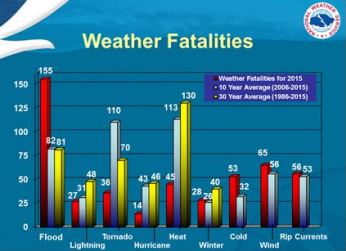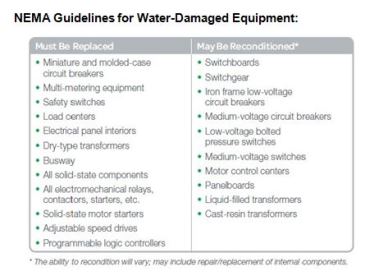Welcome Summer ... and the 2016 Hurricane Season
 The Atlantic hurricane season kicks off on June 1 and runs through Nov. 30. According to the National Oceanic and Atmospheric Administration (NOAA), "Tropical cyclones are among nature's most powerful and destructive phenomena." Coastal areas are at risk for storm surge, extreme winds, and flooding from rain. Once a hurricane makes landfall, inland areas in its path are at risk for high winds, thunderstorms, and flooding.
The Atlantic hurricane season kicks off on June 1 and runs through Nov. 30. According to the National Oceanic and Atmospheric Administration (NOAA), "Tropical cyclones are among nature's most powerful and destructive phenomena." Coastal areas are at risk for storm surge, extreme winds, and flooding from rain. Once a hurricane makes landfall, inland areas in its path are at risk for high winds, thunderstorms, and flooding.
Predictions for 2016 season are that it will be more active than average. Whether the season is an active one or remains relatively light, it takes just one storm to cause major devastation in terms of life and property.
In terms of financial losses, NOAA lists the following hurricanes as the costliest within the past 25 years:
- 2012 - Hurricane Sandy ($65.0 billion)
- 2008 - Hurricane Ike ($29.5 billion)
- 2005 - Hurricane Katrina ($108.0 billion)
- 2005 - Hurricane Wilma ($21.0 billion)
- 1992 - Hurricane Andrew ($26.5 billion)
Flooding is often an outcome of these storms. This article identifies pre-planning exercises companies can complete to help restore water-damaged electrical distribution and control equipment efficiently.
1. Ensure electrical equipment is properly maintained.
For business owners, having electrical equipment properly maintained is helpful in getting the electrical system up and running more efficiently. This includes having updated system documentation, including one-line diagrams, maintenance records, and regularly testing on-site generators.
2. Develop a safety program that incorporates emergency procedures.
An Electrical Safety Program (ESP) is a written document created by the employer that includes policies, procedures, and process controls. A good starting point is to have a risk assessment performed by professional engineers. The following guidelines may help in developing this program:
Facility – Includes company policies and systems
- Equipment maintenance
- Tools
- Testing
- Repairs
- Clearance limits
- Safe working conditions
Personnel – Focuses on actual work practices
- Qualified and unqualified personnel
- Proper care and use of PPE
- Job preparedness
- Training and continuing education
Procedures – References on-the-job procedures and includes (but not limited to):
- Performing energized work
- De-energizing and re-energizing
- Lockout/tagout
- Job planning
- Arc flash hazard analysis
- Equipment labeling
- Reporting safety concerns
- Recordkeeping
NFPA 70E states that field work shall be audited on an annual basis to ensure that each worker is complying with the ESP. The ESP shall be audited at intervals not to exceed three years to verify the principles and procedures remain in compliance.
3. Develop an electrical emergency action plan (EEAP).
The ESP should include an action plan for emergency situations. Employers and employees should be very familiar with emergency procedures and safe work practices. The purpose of the EEAP is to understand the electrical assets, critical operational infrastructure, risks, and short- and long-term power restoration execution plans. Considerations for developing an EEAP include:
- Determine priorities: The plan should have a clear definition of what constitutes an emergency and when to execute the EEAP. Prioritizing critical functions is essential to efficiently and safety restoring power.
- Emergency service contracts: Searching for temporary equipment after a disaster can be a time-consuming process and very expensive. The EEAP should include emergency service contracts, critical equipment pricing, lead times, and a deployment strategy with details on setting up and operating a command center to meet an organization's needs.
- Critical spare parts: Have a current single-line electrical diagram of the power distribution system and pinpoint the electrical equipment essential to business operations. Identify the equipment's critical spares parts' availability, pricing, and lead times for custom-made parts.
4. Be aware of the most current natural disaster recovery codes and standards.
NFPA 1600 is the overarching standard and primary document on disaster recovery, emergency management, and business continuity.
NFPA 70B-2016, Recommended Practice for Electrical Equipment Maintenance, includes Chapter 32 on Electrical Disaster Recovery. Article 32.2.8, Industry Standards and Guidelines, provides a comprehensive list of resources.
The National Electrical Manufacturers Association (NEMA) has published "Evaluating Water-Damaged Electrical Equipment" and is currently working on a guide for "Evaluating Fire- and Heat-Damaged Electrical Equipment."
 5. Know the effects of water damage to electrical equipment.
5. Know the effects of water damage to electrical equipment.
Perhaps the best preparation is knowing what to do and what not to do following a disaster. This is critical, because attempting to restore electrical power to water-damaged equipment can be deadly.
Whether the equipment is to be replaced or reconditioned, all services should be performed by qualified personnel familiar with the equipment's operation and construction.
Conclusion
While there are very few preventive actions to minimize the impact of a natural disaster, following the emergency preparedness steps outlined above can help recovery efforts and reduce risk of employee injury should your area be in the path of a storm.
Sheri Wood is the Director-Safety and Environment for Schneider Electric USA.
Posted on Jun 01, 2016